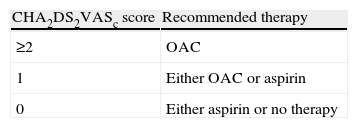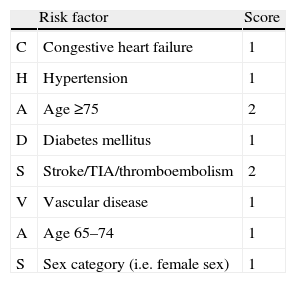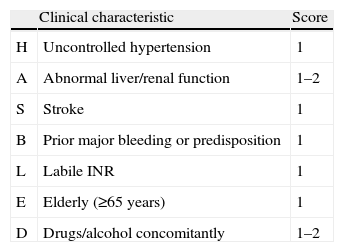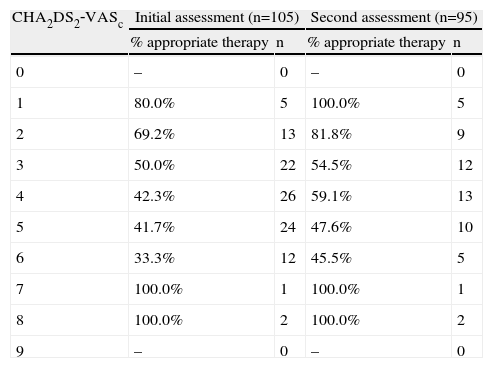Atrial fibrillation is the most common cardiac arrhythmia and has important clinical repercussions, increasing thromboembolic events and mortality. The CHA2DS2‐VASc and HAS‐BLED scores assist the clinician in assessing the benefits and risks of antithrombotic therapy.
ObjectiveThe aim of this study was to assess and improve the quality of prophylactic antithrombotic therapy prescribed to patients with atrial fibrillation.
MethodsThis was a quality study, based on a cycle of assessment and improvement, applied to the population of a family health unit, consisting of an initial assessment, an educational intervention and a second assessment. Both scores were calculated for all patients. Whenever the CHA2DS2‐VASc score recommended initiation of anticoagulation, the risk was calculated by the HAS‐BLED score; it was thus possible to determine for each patient if the prescribed therapy was appropriate.
ResultsThe first assessment included 105 patients, of whom 49.5% had appropriate prophylactic therapy according to their scores. In the second assessment, four months after the educational intervention, 60.0% had been prescribed appropriate therapy, which represented a 21.2% improvement.
ConclusionsIn both assessments, inappropriate treatment was due to non‐prescription of prophylactic oral anticoagulation. This quality cycle serves as a tool for continuous assessment in the pursuit of improved care for patients with atrial fibrillation.
A fibrilhação auricular é a arritmia cardíaca mais comum. Tem repercussões clínicas importantes pelo aumento de fenómenos tromboembólicos e da mortalidade. Os scores CHA2DS2VASc e HAS‐BLED auxiliam o clínico a ponderar os benefícios e riscos da terapêutica antitrombótica.
Pretendeu‐se avaliar e melhorar a qualidade da terapêutica profilática antitrombótica prescrita a doentes com fibrilhação auricular.
MétodosÉ um estudo de qualidade integrando um circuito de avaliação e melhoria, aplicado à população de uma unidade de saúde familiar. O ciclo era composto por uma primeira avaliação, intervenção educacional e fechava‐se com uma segunda avaliação. Calcularam‐se ambos os scores para todos os doentes. Sempre que o CHA2DS2VASc recomendava o início de anticoagulantes ponderou‐se o risco versus benefício com o HAS‐BLED. Assim foi possível determinar para cada doente se a terapêutica prescrita era adequada.
ResultadosNa primeira avaliação foram incluídos 105 doentes, dos quais 49,5%, segundo a ponderação dos scores, tinham uma terapêutica profilática adequada. Na segunda avaliação, quatro meses após a intervenção, a adequação terapêutica foi de 60,0%. A variação correspondeu a uma melhoria de 21,2% quanto ao número de doentes com terapêutica adequada.
ConclusõesEm ambas as avaliações a inadequação terapêutica deveu‐se à não instituição de profilaxia com anticoagulantes orais. Este ciclo de qualidade serve como ferramenta para se manter uma avaliação contínua na busca de uma melhoria assistência aos doentes com fibrilhação auricular.
Atrial fibrillation (AF) is the most common cardiac arrhythmia,1,2 with an estimated worldwide prevalence of 1%,1,3 but with considerable geographical variation.2,4,5 In Portugal, AF prevalence in those aged over 40 is 2.5%, rising to 10.4% in those aged over 80,6 and given the direct relationship of AF with age,7 its prevalence is predicted to double within 50 years due to aging populations.8
AF has important clinical repercussions, doubling the overall mortality rate and increasing the incidence of stroke and the number of hospitalizations five‐fold, as well as increasing other thromboembolic events and reducing patients’ quality of life.2,3,9 It is thus important to initiate appropriate prophylactic antithrombotic therapy in order to prevent complications.10
The European Society of Cardiology (ESC) guidelines recommend use of the CHA2DS2‐VASc score in AF patients to stratify 1‐year stroke risk,3 on the basis of which prophylactic antithrombotic therapy can be prescribed (Table 1). However, the risk of bleeding complications should be assessed in all cases in which oral anticoagulation (OAC) is being considered. For OAC therapy to be prescribed, the benefit of stroke risk reduction must be higher than the bleeding risk. Various bleeding risk scores have been developed to assist the clinician in this decision; one is the HAS‐BLED score,11 which enables bleeding risk to be calculated in AF patients and is thus a valuable tool in deciding whether to introduce antithrombotic therapy.
In clinical practice, the risks and benefits of OAC therapy should be assessed on the basis of the CHA2DS2‐VASc and HAS‐BLED scores. A patient with a CHA2DS2‐VASc score of ≥2 has a thrombotic risk that indicates OAC therapy, but the bleeding risk of OAC outweighs the benefits if the HAS‐BLED score is greater than the CHA2DS2VASc score.11 In cases where the CHA2DS2‐VASc score is 1, the bleeding risk outweighs the benefits if the HAS‐BLED score is ≥3.3,11
The aim of this study was to assess and improve the quality of prophylactic antithrombotic therapy prescribed to patients with AF through a quality cycle of assessment and improvement in our family health unit (FHU).
MethodsThis was a quality study, based on a cycle of assessment and improvement of prophylactic antithrombotic therapy prescribed to patients with AF.
The study population was a sample selected from the list of patients registered at our FHU. The target population consisted of patients recorded in the database with a diagnosis under at least one of the following International Classification of Primary Care (ICPC‐2) codes12: K78 (atrial fibrillation/flutter) or K80 (cardiac arrhythmia not otherwise specified), the latter being included in order to minimize any bias caused by incorrect classification of a cardiac problem. However, only patients with AF documented by a diagnostic exam (ECG or Holter monitoring) recorded in their medical record were included. Patients whose medical records showed conversion of AF or who had had fewer than two consultations at the FHU in the 12 months prior to the start of the study were excluded, with the aim of preventing use of out‐of‐date information.
The CHA2DS2‐VASc and HAS‐BLED scores were calculated for all patients, even though both are considered only when there is an indication for OAC therapy.
The CHA2DS2‐VASc score is based on eight parameters (Table 2). Congestive heart failure corresponds to code K77 (heart failure); patients were considered to have hypertension (HTN) if their medical records showed a diagnosis under the ICPC‐2 codes K86 (HTN uncomplicated) or K87 (HTN complicated), diabetes with codes T89 (diabetes insulin dependent) or T90 (diabetes non‐insulin dependent), a history of thromboembolic events if records showed codes K89 (transient cerebral ischemia), K90 (stroke/cerebrovascular accident) or K94 (phlebitis/thrombophlebitis), and vascular disease if records showed K74 (ischemic heart disease with angina), K75 (acute myocardial infarction) or K76 (ischemic heart disease without angina).
The HAS‐BLED score is based on seven parameters (Table 3). Patients with a history of hypertension were attributed one point for uncontrolled hypertension if they had systolic blood pressure of >160 mmHg documented in the previous 12 months. Patients were considered to have renal dysfunction if they had a history of dialysis, renal transplant or creatinine >2.25 mg/dl, and abnormal liver function if there was a record of cirrhosis or biochemical evidence of liver disease, such as total bilirubin of >1.0 mg/dl, together with elevation of at least one liver enzyme (aspartate aminotransferase, alanine transferase or alkaline phosphatase) to three times normal levels. A history of stroke was defined as a recorded diagnosis under ICPC‐2 codes K91 (cerebrovascular disease) or K90 (stroke/cerebrovascular accident). The parameter “Drugs/alcohol” refers to concomitant use of drugs, such as antiplatelet agents and non‐steroidal anti‐inflammatory drugs (NSAIDs), as recorded in the field “Chronic medication”; alcohol use was considered relevant if there was a record of problems under code P15 (chronic alcohol abuse). The parameters “Bleeding” and “Labile INR” were scored as 0, due to the lack of data in medical records.
Clinical characteristics used to calculate the HAS‐BLED score.
| Clinical characteristic | Score | |
| H | Uncontrolled hypertension | 1 |
| A | Abnormal liver/renal function | 1–2 |
| S | Stroke | 1 |
| B | Prior major bleeding or predisposition | 1 |
| L | Labile INR | 1 |
| E | Elderly (≥65 years) | 1 |
| D | Drugs/alcohol concomitantly | 1–2 |
INR: international normalized ratio.
The appropriateness of the prescribed prophylactic antithrombotic therapy was assessed for each individual patient, with both scores being taken into account whenever the CHA2DS2‐VASc score indicated OAC therapy; it was thus possible to determine whether the therapy prescribed for each patient was appropriate or inappropriate.
The quality cycle lasted four months, consisting of an initial assessment, an educational intervention and a second assessment.
The initial assessment was designed to determine the quality of prophylactic antithrombotic therapy at the FHU. The results were presented to the medical team at a clinical meeting, at which each physician was given a list of patients under their care receiving inappropriate therapy, followed by discussion. Self‐evaluation and internal assessment of the results were encouraged with the aim of improving the quality of care.
The educational intervention consisted of an oral presentation by the investigators one week later on prophylactic antithrombotic therapy in AF using the CHA2DS2‐VASc and HAS‐BLED scores, based on the ESC guidelines for the management of AF3 and the study describing the HAS‐BLED score.11
A second assessment was carried out four months later and the results presented for internal evaluation.
The data required to calculate the scores were collected from computerized medical records using MedicineOne software. The statistical analysis was performed using Microsoft Excel 2010.
ResultsData for the initial assessment were collected by the investigators between May 1 and May 4, 2012. The study population was selected from 15 749 patients registered at the FHU.
The initial assessment included 105 patients with AF, representing a prevalence of 0.7%, of whom 50.5% (n=53) were women, with a mean age of 74.3±9.44 years.
Analysis of CHA2DS2‐VASc scores revealed that 95.2% (n=100) of the study population had a score of ≥2, which places patients at high risk for stroke. The most common risk factor was hypertension, affecting 81.9% (n=86) of patients, followed by heart failure (52.4%, n=55), diabetes (26.7%, n=28), vascular disease (19.0%, n=20) and a history of thromboembolic events (14.3%, n=15). With regard to age‐related risk, 33.3% (n=35) were aged between 65 and 74, and 52.4% (n=55) were aged over 74.
Bleeding risk was assessed in all patients; 21.0% (n=22) had a HAS‐BLED score of ≥3, which means close monitoring is essential if OAC therapy is introduced.
The most common of the HAS‐BLED risk factors was age over 65 years (84.8%, n=89), followed by medication with antiplatelets or NSAIDs (53.3%, n=56), uncontrolled hypertension (18.1%, n=19), previous stroke (14.3%, n=15), abnormal liver or renal function (4.8%, n=5) and a history of alcohol abuse (3.8%, n=4). Analysis of the scores showed that 49.5% (n=52) were receiving appropriate therapy.
Analysis of the percentage receiving appropriate therapy according to the CHA2DS2‐VASc score showed that this diminished as the score increased up to a score of 7, when it became 100% (Table 4). No patient prescribed OAC therapy fails to benefit; inappropriate treatment consists of not introducing such therapy in patients who would benefit from it (Table 5).
Percentage receiving appropriate therapy according to the CHA2DS2‐VASc score.
| CHA2DS2‐VASc | Initial assessment (n=105) | Second assessment (n=95) | ||
| % appropriate therapy | n | % appropriate therapy | n | |
| 0 | – | 0 | – | 0 |
| 1 | 80.0% | 5 | 100.0% | 5 |
| 2 | 69.2% | 13 | 81.8% | 9 |
| 3 | 50.0% | 22 | 54.5% | 12 |
| 4 | 42.3% | 26 | 59.1% | 13 |
| 5 | 41.7% | 24 | 47.6% | 10 |
| 6 | 33.3% | 12 | 45.5% | 5 |
| 7 | 100.0% | 1 | 100.0% | 1 |
| 8 | 100.0% | 2 | 100.0% | 2 |
| 9 | – | 0 | – | 0 |
n: total number of patients with atrial fibrillation.
Percentage receiving appropriate therapy according to that indicated by weighing both scores.
| Antithrombotic therapy indicated | Initial assessment (n=105) | Second assessment (n=95) | ||
| % appropriate therapy | n | % appropriate therapy | n | |
| Aspirin or no therapy | 100.0% | 3 | 100.0% | 3 |
| Aspirin or OAC | 80.0% | 5 | 100.0% | 5 |
| OAC | 46.4% | 97 | 56.3% | 87 |
n: total number of patients with atrial fibrillation; OAC: oral anticoagulation.
Data for the second assessment were collected between September 3 and September 7, 2012, four months after the educational intervention. The selected sample consisted of 95 patients, of whom 50.5% (n=48) were women, with a mean age of 73.6±9.21 years.
The CHA2DS2‐VASc score was ≥2 in 94.7% (n=90) of patients, and 21.1% (n=20) had a HAS‐BLED score of ≥3.
At the second assessment, the proportion receiving appropriate therapy was 60.0% (n=57), a 21.2% improvement in the number under appropriate therapy compared to the first assessment.
Analysis of the percentage receiving appropriate therapy according to the CHA2DS2‐VASc score revealed that this diminished as the score rose between 2 and 6 (Table 4).
All patients who will not benefit from or who have no strict indication for OAC therapy are now appropriately treated. As was the case for the first assessment, inappropriate treatment consists of not introducing prophylactic OAC therapy in patients who would benefit from it (Table 5).
DiscussionThis study is original in applying a cycle of quality assessment and improvement in prophylactic antithrombotic therapy prescribed to AF patients in an FHU. It was designed as an internal evaluation procedure, which it is hoped other units will emulate.
The impact that AF has in clinical practice and in patients’ lives, together with the predicted doubling of its prevalence, alerted us to the need for new strategies. We designed this quality cycle to serve as a structured approach to improving prescription of antithrombotic therapy.
Such quality assessments have become increasingly important given the evidence on the rates of AF diagnosis and prescription of OAC therapy. The FAMA study, of a representative sample of the Portuguese population aged over 40, showed that AF is underdiagnosed and that only 38.5% of AF patients are prescribed OAC therapy.6 In our study, the proportion of patients receiving OAC therapy even before the educational intervention (49.5%) was greater than that reported in the FAMA study. The difference in the provenance of the two samples may explain this; unlike FAMA, our study was not of a representative sample of the general population but of patients registered at an FHU, who will tend to be under closer medical vigilance, since the work of such units is guided by performance indicators, which has a positive influence on results.
The Portuguese Rede de Médicos Sentinela (network of sentinel physicians) conducted a study in 2006 aimed at characterizing AF and the therapeutic regimens used in primary health care and found that 46.5% of patients were receiving OAC therapy.13
A 2010 study in an FHU of AF patients aged over 80 showed that only 35.5% were receiving OAC and almost 10% were prescribed no antithrombotic therapy.14 Wider dissemination of such data could be a good way to increase knowledge and general awareness of this problem, and thus improve diagnosis and compliance with therapy.
A quality cycle is an excellent tool for improving patient care as it enables bad practice to be identified, results to be compared and knowledge to be updated, for example by drawing attention to the 2012 focused update of ESC guidelines for the management of AF.15 The main change in the new guidelines is that OAC therapy, rather than antiplatelet agents, should be introduced for a CHA2DS2‐VASc score of 1 whenever possible. The educational intervention in our study took place before publication of the guideline update, and the second assessment was based on the guidelines available at the time. Reanalysis of the data from the second assessment in the light of the updated guidelines shows that the proportion of patients receiving appropriate therapy would be 56.8%.
Unlike the original validation of the HAS‐BLED score,11 the new ESC guidelines do not consider this score to be sufficient reason in itself to exclude OAC therapy. Although in our study no patient was receiving OAC therapy who should not have been according to the two scores in conjunction, caution is required in interpreting the HAS‐BLED score in our population as methodological limitations meant that it was underestimated. Nevertheless, there is consensus that patients with a HAS‐BLED score of ≥3 should be closely monitored if OAC therapy is introduced, although it is not an absolute contraindication.
Study limitationsThe main methodological limitation was the provenance of the data used in the study. Patient selection based on codes for the classification of health problems contained in medical records raises the possibility of undersampling due to incorrect classification. The lack of data on diagnostic exams may also have resulted in undersampling. In addition, some patients may no longer have had AF due to a conversion process, but this information was not available. The fact that some records were incomplete could have led to errors in patient selection and in calculation of the scores, particularly in the case of the HAS‐BLED score, which was underestimated since not all risk factors could be assessed.
The prevalence of AF in our study population (0.7%) was lower than reported for Portuguese (2.5%)6 and other populations (1.0%).1,3 This may be due to regional variation in prevalence and to the above methodological limitations.
The educational intervention was designed by the investigators, since no validated model was found in the available information sources.
On the basis of the CHA2DS2‐VASc and HAS‐BLED scores in conjunction, we would have expected more patients to be prescribed OAC therapy than observed. The quality cycle is specifically designed to improve performance in this respect by increasing the number of appropriately treated patients.
Patients should be assessed on an individual basis, since they often have characteristics that are not covered in clinical guidelines but which the clinician should take into account, in order to properly weigh the risks and benefits of OAC therapy.
The development of new anticoagulant agents, with different pharmacokinetic and pharmacodynamic properties, may change current practices for monitoring anticoagulated patients, thereby helping improve levels of appropriate therapy.
Continuing with such quality cycles will lead to progressive improvement in the number of patients receiving appropriate treatment, in step with scientific advances.
ConclusionsThe CHA2DS2‐VASc and HAS‐BLED scores enable clinicians to make informed evidence‐based treatment decisions and are important tools in overcoming the difficulties that can arise when deciding whether to initiate OAC therapy.
The organizational framework of an FHU is conducive to improving treatment of AF patients; this study could serve as the basis for comparison with similar quality cycles in other units, as evaluating performance is an essential step in improving patient care.
Ethical disclosuresProtection of human and animal subjectsThe authors declare that no experiments were performed on humans or animals for this study.
Confidentiality of dataThe authors declare that they have followed the protocols of their work center on the publication of patient data and that all the patients included in the study received sufficient information and gave their written informed consent to participate in the study.
Right to privacy and informed consentThe authors declare that no patient data appear in this article.
Conflicts of interestThe authors have no conflicts of interest to declare.
Please cite this article as: Oliveira R, Grilo S, Moreira C, et al. Um estudo de qualidade numa unidade de saúde familiar para a melhoria da qualidade da terapêutica profilática antitrombótica prescrita a doentes com fibrilhação auricular. Rev Port Cardiol. 2014;33:89–94.










